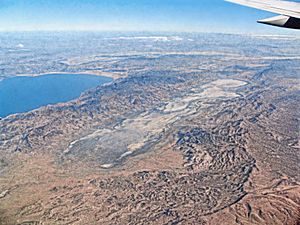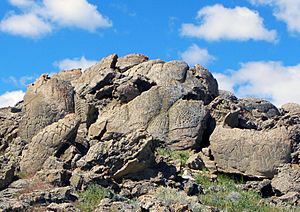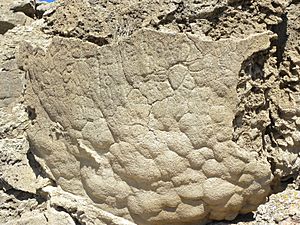Winnemucca Lake facts for kids
Quick facts for kids Winnemucca Lake |
|
|---|---|
| Lua error in Module:Location_map at line 420: attempt to index field 'wikibase' (a nil value). | |
| Surface elevation | 1,704 m (5,591 ft) |
Winnemucca Lake is a dry lake bed in northwest Nevada. It is famous for having the oldest known rock carvings in North America. This area is located where Washoe and Pershing counties meet.
Winnemucca Lake used to be a shallow lake until the 1930s. It dried up after a dam and a road were built. These structures stopped water from flowing into the lake. It was once a special place for birds, called a National Wildlife Refuge. But this status was removed because there was no longer any water.
Scientists have studied the rock carvings at Winnemucca Lake for a long time. In 2013, they found that these carvings are between 14,800 and 10,500 years old. This makes them the oldest rock carvings ever found in North America. The carvings are located on the Pyramid Lake Indian Reservation.
Contents
Where is Winnemucca Lake?
Winnemucca Lake is in the northwest part of Nevada. It is a sub-basin within the larger Lahontan Basin. The lake bed is found east of Pyramid Lake. It sits on the border between Washoe and Pershing counties.
The lake bed is surrounded by mountains. The Lake Range is to the west, and the Nightingale Mountains and Selenite Range are to the east. Winnemucca Lake is about 45 kilometers (28 miles) long. It is also about 7 kilometers (4 miles) wide. The lake bed is at an elevation of about 1,150 meters (3,770 feet). This is lower than the water level of Pyramid Lake, which is next to it.
History of the Lake
Winnemucca Lake might have been dry when John Frémont explored the area in 1843–44. His map from 1844 shows he traveled west of the lake. It does not show the Winnemucca Lake valley itself. Some reports say a flood in 1862 filled the lake. Other records suggest the water level was low that year.
In 1865, Winnemucca Lake was known as Mud Lake. A conflict called the Battle of Mud Lake happened there. Soldiers from the 1st Nevada Volunteer Cavalry Battalion fought with some Smoke Creek Indians. Sarah Winnemucca, a famous Paiute author, wrote about this sad event. She said her baby brother was killed there.
The lake reached its highest level in the 1880s. The water was about 26 meters (85 feet) deep then.
Winnemucca Lake was once a shallow lake filled with tule plants. It was a very important stop for migrating waterfowl (birds that live near water). However, things changed after the Derby Dam was built in 1903. This dam was on the Truckee River. Also, Nevada State Route 447 was built. This road blocked the connection between Winnemucca Lake and Pyramid Lake. Because of these changes, Winnemucca Lake dried up. It has been mostly dry since the late 1930s.
In 1936, President Franklin D. Roosevelt created the Winnemucca Migratory Bird Refuge. This was meant to be a safe place for birds and other wildlife. In 1940, its name changed to the Winnemucca National Wildlife Refuge. But in 1962, the refuge status was removed. This was because there was no water left for the birds. It was the first time a wildlife refuge lost its status due to lack of water.
Ancient Rock Carvings
The western side of Winnemucca Lake has many large rocks with petroglyphs carved into them. These carvings are on the Pyramid Lake Indian Reservation. Researchers first described this site in 1992. They thought the carvings were very old and unique.
In 1994, a scientist named Larry Benson studied the carvings. He found they were carved into a type of limestone called tufa. This limestone formed between 16,200 and 14,800 years ago. This showed that the carvings were very ancient.
Dating the Petroglyphs
In 2013, a team of scientists from the University of Colorado at Boulder did more research. They used special methods like radiocarbon dating to find out when the carvings were made. They studied layers of rock and algae from the site. They also looked at samples from nearby Pyramid Lake. This helped them understand when the water level was low enough for people to carve on the rocks.
The scientists found that the rocks were above the water at two different times. One period was between 14,800 and 13,200 years ago. The other was between 11,300 and 10,500 years ago. Either of these time periods makes the Winnemucca Lake petroglyphs the oldest known in North America. The older date is around the time when the first humans might have arrived in North America.
What the Carvings Look Like
The carvings include simple shapes like straight lines and swirls. There are also more complex designs. Some look like trees, flowers, or the veins of a leaf. One rock has a detailed diamond pattern.
The smallest carvings are about 8 inches (20 cm) wide. The largest are about 3 feet (1 meter) wide. The grooves carved into the rocks are about 0.4 to 0.8 inches (1 to 2 cm) deep. These carvings are deeper and larger than many other rock carvings found in the southwestern United States.
We do not know what the carvings mean. Some scientists think they might represent weather symbols, like clouds or lightning. The way these carvings look is similar to other very old petroglyphs found in Oregon.
Scientists think the carvings were made by chipping away at the softer rock layers. They might have used harder volcanic rocks as tools.
Images for kids







